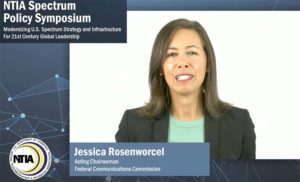The NTIA held its annual spectrum policy symposium, titled “Modernizing U.S. Spectrum Strategy and Infrastructure For 21st Century Global Leadership,” this week.
Speakers included Secretary of Commerce Gina Raimondo; Charles Cooper, NTIA Office of Spectrum Management; Rep. Mike Doyle, Chairman, Subcommittee on Communications and Technology, House Committee on Energy & Commerce; and of course Acting FCC Chairwoman Jessica Rosenworcel along with many additional spectrum policy experts and stakeholders.
They discussed at length plans for mid-band spectrum access, spectrum sharing approaches and techniques, and innovative, dynamic spectrum management tools and concepts.
What were some of the top themes that rose to the surface from the day’s events? We have you covered. (Comments paraphrased for brevity and context.)
Spectrum’s role in the COVID-19 pandemic and recovery:
Raimondo: We learned during the pandemic that high speed internet isn’t a luxury. It’s essential to everyday life, from jobs to healthcare, and education.
Cooper: This pandemic has heightened the importance of teleworking, telemedicine, and remote schooling. It has shown us how reliant we are upon these technologies and spectrum-dependent systems that are integral. Even more, we know that wireless networks are a key factor in our ongoing economic recovery.
Spectrum as catalyst for innovation: Many speakers referenced the great progress achieved in recent years due to policy changes allowing the U.S. to become a global leader.
Rosenworcel: If you look at the history of the wireless revolution, you see that a big reason the United States has been a global leader in mobile innovation is that we have led on spectrum policy innovation. Time and again, we have done so many unconventional things—and we have done them first.
Rosenworcel: We pioneered the use of unlicensed spectrum. We took a handful of underused frequencies, we put in place a new model that set technical parameters and then we gave the public access to these airwaves. This was edgy stuff. It was a move away from command and control spectrum policy. And this experiment was a wild success. Because this is the spectrum where Wi-Fi was born.
Ruth Milkman, Quadra Partners, LLC: If you have low barriers to spectrum access, that can yield innovation and competition, and uses by non-traditional companies.
Collaboration and sharing spectrum among all stakeholders:
Rep. Doyle: When we are balancing multiple public policy goals, no single stakeholder should make the final decision on such policy, which is why we thank NTIA for bringing a range of stakeholders together to make these decisions.
Brian Regan, Starry, Inc.: Starry is just one part of the success story and how that can work, where given the availability of spectrum that is high quality, shared, that has low barriers to access, you can really add a multiplying effect from an economic and technological perspective.
Future projections:
Rep. Doyle: Getting America 100% connected is a nation-wide effort and NTIA’s solutions will be critical in moving this forward.
One simple question: On next year’s panel, are they going to be talking more about 6G or 5G? Regan: Both, hopefully 6G.

